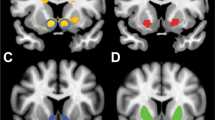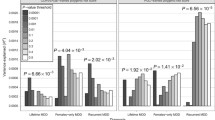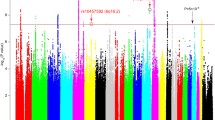Abstract
A recent study reported a negative association between a putatively functional dopamine (DA) polygenic score, indexing higher levels of DA signaling, and depressive symptoms. We attempted to replicate this association using data from the Duke Neurogenetics Study. Our replication attempt was made in a subsample of 520 non-Hispanic Caucasian volunteers (277 women, mean age 19.78 ± 1.24 years). The DA polygenic score was based on the following five loci: rs27072 (SLC6A3/DAT1), rs4532 (DRD1), rs1800497 (DRD2/ANKK1), rs6280 (DRD3), and rs4680 (COMT). Because the discovery sample in the original study consisted mostly of Asian participants, we also conducted a post hoc analysis in a smaller subsample of Asian volunteers (N = 316, 179 women, mean age 19.61 ± 1.32 years). In the primary sample of non-Hispanic Caucasians, a linear regression analysis controlling for sex, age, socioeconomic status (SES), body mass index, genetic ancestry, and both early and recent life stress, revealed that higher DA polygenic scores were associated with higher self-reported symptoms of depression. This was in contrast to the original association of higher DA polygenic scores and lower depressive symptoms. However, the direction of the association in our Asian subsample was consistent with this original finding. Our results also suggested that compared to the Asian subsample, the non-Hispanic Caucasian subsample was characterized by higher SES, lower early and recent life stress, and lower depressive symptoms. These differences may have contributed to the observed divergence in associations. Collectively, the current findings add to evidence that specific genetic associations may differ between populations and further encourage explicit modeling of race/ethnicity in examining the polygenic nature of depressive symptoms and depression.

Similar content being viewed by others
References
Grace AA (2016) Dysregulation of the dopamine system in the pathophysiology of schizophrenia and depression. Nat Rev Neurosci 17:524
Belujon P, Grace AA (2017) Dopamine system dysregulation in major depressive disorders. Int J Neuropsychopharmacol 20:1036–1046
Howard DM, Adams MJ, Shirali M et al (2018) Genome-wide association study of depression phenotypes in UK biobank identifies variants in excitatory synaptic pathways. Nat Commun 9:1470
Wray NR, Ripke S, Mattheisen M et al (2018) Genome-wide association analyses identify 44 risk variants and refine the genetic architecture of major depression. Nat Genet 50:668–681
Pearson-Fuhrhop KM, Dunn EC, Mortero S et al (2014) Dopamine genetic risk score predicts depressive symptoms in healthy adults and adults with depression. PLoS One 9:e93772
Wise R (2004) Dopamine, learning and motivation. Nat Rev Neurosci 5:483–494
Wise R (2008) Dopamine and reward: the anhedonia hypothesis 30 years on. Neurotox Res 14:169–183
Lecrubier Y, Sheehan DV, Weiller E et al (1997) The mini international neuropsychiatric interview (mini). A short diagnostic structured interview: reliability and validity according to the CIDI. Eur Psychiatry 12:224–231
First MB, Gibbon M, Spitzer RL et al (1997) Structured clinical interview for DSM-IV axis II personality disorders, (SCID-II). American Psychiatric Press, Washington, DC
Adler NE, Epel ES, Castellazzo G et al (2000) Relationship of subjective and objective social status with psychological and physiological functioning: preliminary data in healthy, white women. Health Psychol 19:586
Purcell S, Neale B, Todd-Brown K et al (2007) Plink: a tool set for whole-genome association and population-based linkage analyses. Am J Hum Genet 81:559–575
Radloff LS (1977) The CES-D scale: a self-report depression scale for research in the general population. Appl Psychol Meas 1:385–401
Bernstein DP, Stein JA, Newcomb MD et al (2003) Development and validation of a brief screening version of the childhood trauma questionnaire. Child Abuse Negl 27:169–190
Clements K, Turpin G (1996) The life events scale for students: validation for use with british samples. Pers Individ Differ 20:747–751
Avinun R, Nevo A, Knodt AR et al (2017) Reward-related ventral striatum activity buffers against the experience of depressive symptoms associated with sleep disturbances. J Neurosci 37:9724–9729
Nikolova YS, Bogdan R, Brigidi BD et al (2012) Ventral striatum reactivity to reward and recent life stress interact to predict positive affect. Biol Psychiatry 72:157–163
Johnston E, Johnson S, McLeod P et al (2004) The relation of body mass index to depressive symptoms. Can J Public Health 95:179–183
Do CB, Tung JY, Dorfman E et al (2011) Web-based genome-wide association study identifies two novel loci and a substantial genetic component for parkinson’s disease. PLoS Genet 7:e1002141
Eriksson N, Macpherson JM, Tung JY et al (2010) Web-based, participant-driven studies yield novel genetic associations for common traits. PLoS Genet 6:e1000993
Tung JY, Do CB, Hinds DA et al (2011) Efficient replication of over 180 genetic associations with self-reported medical data. PLoS One 6:e23473
Muthén LK, Muthén BO (2007) Mplus user’s guide. Muthén & Muthén, Los Angeles
Avinun R, Nevo A, Knodt AR et al (2018) Replication in imaging genetics: the case of threat-related amygdala reactivity. Biol Psychiatry 84:148–159
van Aert RC, van Assen MA (2018) Examining reproducibility in psychology: a hybrid method for combining a statistically significant original study and a replication. Behav Res Methods 50:1515–1539
Savitz J, Hodgkinson CA, Martin-Soelch C et al (2013) DRD2/ANKK1 Taq1A polymorphism (rs1800497) has opposing effects on d2/3 receptor binding in healthy controls and patients with major depressive disorder. Int J Neuropsychopharmacol 16:2095–2101
Karrer TM, Josef AK, Mata R et al (2017) Reduced dopamine receptors and transporters but not synthesis capacity in normal aging adults: a meta-analysis. Neurobiol Aging 57:36–46
Nikolaidis A, Gray JR (2009) ADHD and the DRD4 exon III 7-repeat polymorphism: an international meta-analysis. Soc Cogn Affect Neurosci 5:188–193
Cerasa A, Gioia MC, Labate A et al (2008) Impact of catechol-o-methyltransferase Val108/158 met genotype on hippocampal and prefrontal gray matter volume. Neuroreport 19:405–408
Wang Y, Li J, Chen C et al (2013) Comt rs4680 met is not always the ‘smart allele’: Val allele is associated with better working memory and larger hippocampal volume in healthy chinese. Genes Brain Behav 12:323–329
Klengel T, Binder EB (2015) Epigenetics of stress-related psychiatric disorders and gene × environment interactions. Neuron 86:1343–1357
Belujon P, Grace AA (2015) Regulation of dopamine system responsivity and its adaptive and pathological response to stress. Proc R Soc B Biol Sci 282:20142516
Kim HS, Sherman DK, Mojaverian T et al (2011) Gene–culture interaction: oxytocin receptor polymorphism (OXTR) and emotion regulation. Soc Psychol Pers Sci 2:665–672
Avinun R, Davidov M, Mankuta D et al (2018) Predicting the use of corporal punishment: child aggression, parent religiosity, and the BDNF gene. Aggress Behav 44:165–175
GTEx Consortium (2013) The genotype-tissue expression (GTEX) project. Nat Genet 45:580
Boyle EA, Li YI, Pritchard JK (2017) An expanded view of complex traits: from polygenic to omnigenic. Cell 169:1177–1186
Ray LA, Bujarski S, Chin PF et al (2011) Pharmacogenetics of naltrexone in Asian Americans: a randomized placebo-controlled laboratory study. Neuropsychopharmacology 37:445
Kato M, Zanardi R, Rossini D et al (2009) 5-HT2A gene variants influence specific and different aspects of antidepressant response in japanese and italian mood disorder patients. Psychiatry Res 167:97–105
Porcelli S, Fabbri C, Serretti A (2012) Meta-analysis of serotonin transporter gene promoter polymorphism (5-HTTLPR) association with antidepressant efficacy. Eur Neuropsychopharmacol 22:239–258
Shen H, He MM, Liu H et al (2007) Comparative metabolic capabilities and inhibitory profiles of CYP2D6. 1, CYP2D6. 10, and CYP2D6. 17. Drug Metab Dispos 35:1292–1300
Huang W, Ma JZ, Payne TJ et al (2008) Significant association of DRD1 with nicotine dependence. Hum Genet 123:133–140
Ota VK, Spindola LN, Gadelha A et al (2012) Drd1 rs4532 polymorphism: a potential pharmacogenomic marker for treatment response to antipsychotic drugs. Schizophr Res 142:206–208
Ferrari M, Comi C, Marino F et al (2016) Polymorphisms of dopamine receptor genes and risk of visual hallucinations in Parkinson’s patients. Eur J Clin Pharmacol 72:1335–1341
Thompson J, Thomas N, Singleton A et al (1997) D2 dopamine receptor gene (DRD2) taq1 a polymorphism: reduced dopamine d2 receptor binding in the human striatum associated with the a1 allele. Pharmacogenetics 7:479–484
Noble E, Blum K, Ritchie T et al (1991) Allelic association of the d2 dopamine receptor gene with receptor-binding characteristics in alcoholism. Arch Gen Psychiatry 48:648–654
Stice E, Spoor S, Bohon C et al (2008) Relation between obesity and blunted striatal response to food is moderated by TaqIA A1 allele. Science 322:449–452
Jeanneteau F, Funalot B, Jankovic J et al (2006) A functional variant of the dopamine d3 receptor is associated with risk and age-at-onset of essential tremor. Proc Natl Acad Sci USA 103:10753–10758
Savitz J, Hodgkinson CA, Martin-Soelch C et al (2013) The functional DRD3 ser9gly polymorphism (rs6280) is pleiotropic, affecting reward as well as movement. PLoS One 8:e54108
Lachman HM, Papolos DF, Saito T et al (1996) Human catechol-o-methyltransferase pharmacogenetics: description of a functional polymorphism and its potential application to neuropsychiatric disorders. Pharmacogenetics 6:243–250
Dreher J-C, Kohn P, Kolachana B et al (2009) Variation in dopamine genes influences responsivity of the human reward system. Proc Natl Acad Sci USA 106:617–622
Pinsonneault JK, Han DD, Burdick KE et al (2011) Dopamine transporter gene variant affecting expression in human brain is associated with bipolar disorder. Neuropsychopharmacology 36:1644–1655
Acknowledgements
The authors would like to thank the Duke Neurogenetics Study participants and the staff of the Laboratory of NeuroGenetics, especially Annchen R. Knodt. The Duke Neurogenetics Study was supported by Duke University as well as US-National Institutes of Health Grants R01DA033369 and R01DA031579. RA and ARH received further support from US-National Institutes of Health Grant R01AG049789.
Author information
Authors and Affiliations
Corresponding author
Ethics declarations
Conflict of interest
The authors declare no competing financial or other interests.
Rights and permissions
About this article
Cite this article
Avinun, R., Nevo, A., Radtke, S.R. et al. Divergence of an association between depressive symptoms and a dopamine polygenic score in Caucasians and Asians. Eur Arch Psychiatry Clin Neurosci 270, 229–235 (2020). https://doi.org/10.1007/s00406-019-01040-x
Received:
Accepted:
Published:
Issue Date:
DOI: https://doi.org/10.1007/s00406-019-01040-x




